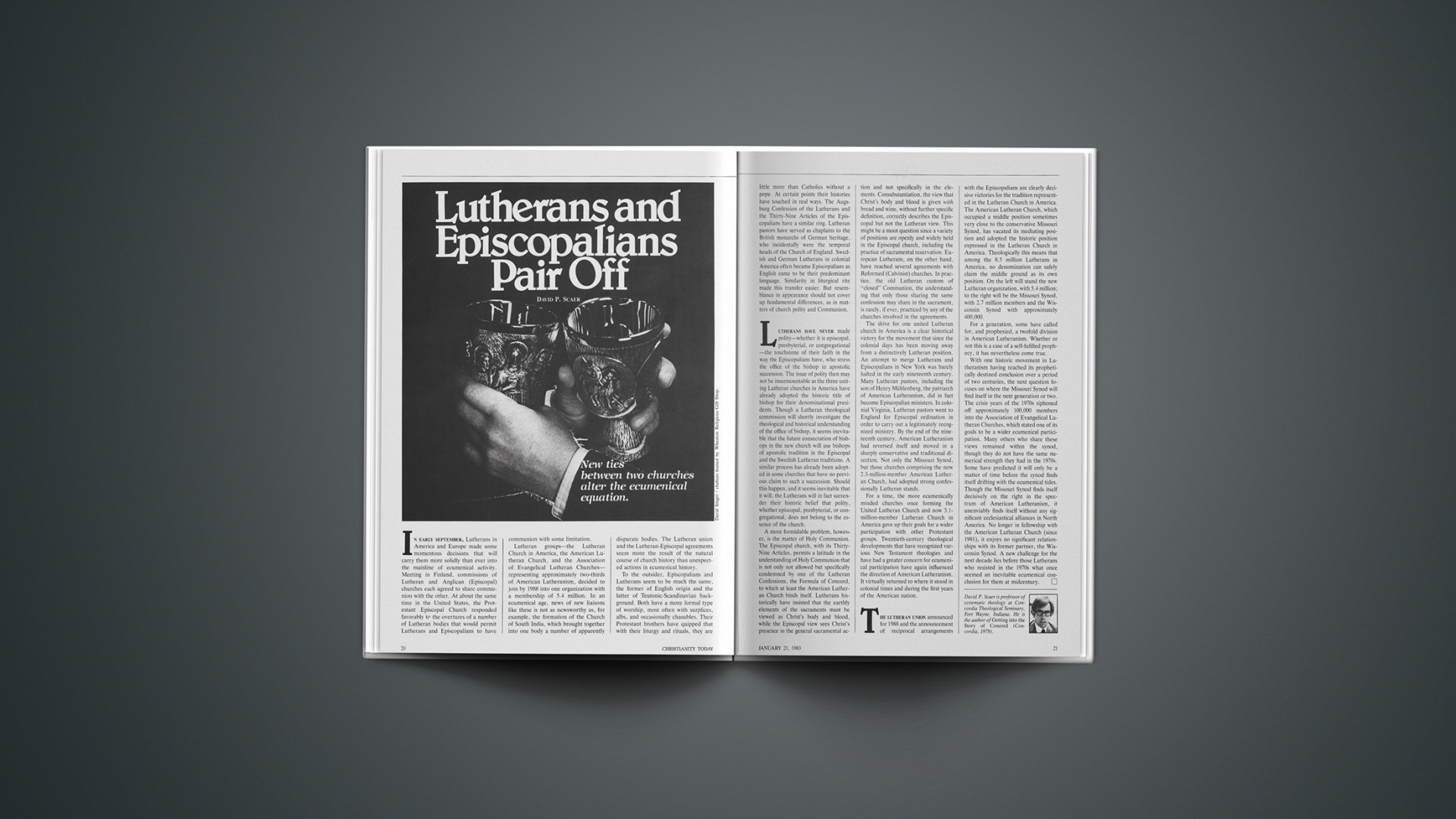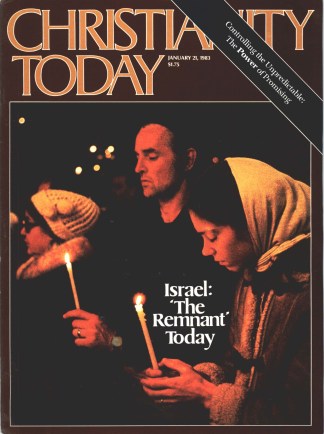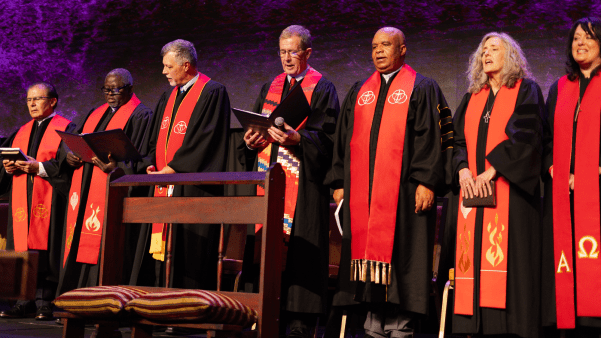New ties between two churches alter the ecumenical equation.
In early September, Lutherans in America and Europe made some momentous decisions that will carry them more solidly than ever into the mainline of ecumenical activity. Meeting in Finland, commissions of Lutheran and Anglican (Episcopal) churches each agreed to share communion with the other. At about the same time in the United States, the Protestant Episcopal Church responded favorably to the overtures of a number of Lutheran bodies that would permit Lutherans and Episcopalians to have communion with some limitation.
Lutheran groups—the Lutheran Church in America, the American Lutheran Church, and the Association of Evangelical Lutheran Churches—representing approximately two-thirds of American Lutheranism, decided to join by 1988 into one organization with a membership of 5.4 million. In an ecumenical age, news of new liaisons like these is not as newsworthy as, for example, the formation of the Church of South India, which brought together into one body a number of apparently disparate bodies. The Lutheran union and the Lutheran-Episcopal agreements seem more the result of the natural course of church history than unexpected actions in ecumenical history.
To the outsider, Episcopalians and Lutherans seem to be much the same, the former of English origin and the latter of Teutonic-Scandinavian background. Both have a more formal type of worship, most often with surplices, albs, and occasionally chasubles. Their Protestant brothers have quipped that with their liturgy and rituals, they are little more than Catholics without a pope. At certain points their histories have touched in real ways. The Augsburg Confession of the Lutherans and the Thirty-Nine Articles of the Episcopalians have a similar ring. Lutheran pastors have served as chaplains to the British monarchs of German heritage, who incidentally were the temporal heads of the Church of England. Swedish and German Lutherans in colonial America often became Episcopalians as English came to be their predominant language. Similarity in liturgical rite made this transfer easier. But resemblance in appearance should not cover up fundamental differences, as in matters of church polity and Communion.
Lutherans have never made polity—whether it is episcopal, presbyterial, or congregational—the touchstone of their faith in the way the Episcopalians have, who stress the office of the bishop in apostolic succession. The issue of polity then may not be insurmountable as the three uniting Lutheran churches in America have already adopted the historic title of bishop for their denominational presidents. Though a Lutheran theological commission will shortly investigate the theological and historical understanding of the office of bishop, it seems inevitable that the future consecration of bishops in the new church will use bishops of apostolic tradition in the Episcopal and the Swedish Lutheran traditions. A similar process has already been adopted in some churches that have no previous claim to such a succession. Should this happen, and it seems inevitable that it will, the Lutherans will in fact surrender their historic belief that polity, whether episcopal, presbyterial, or congregational, does not belong to the essence of the church.
A more formidable problem, however, is the matter of Holy Communion. The Episcopal church, with its Thirty-Nine Articles, permits a latitude in the understanding of Holy Communion that is not only not allowed but specifically condemned by one of the Lutheran Confessions, the Formula of Concord, to which at least the American Lutheran Church binds itself. Lutherans historically have insisted that the earthly elements of the sacraments must be viewed as Christ’s body and blood, while the Episcopal view sees Christ’s presence in the general sacramental action and not specifically in the elements. Consubstantiation, the view that Christ’s body and blood is given with bread and wine, without further specific definition, correctly describes the Episcopal but not the Lutheran view. This might be a moot question since a variety of positions are openly and widely held in the Episcopal church, including the practice of sacramental reservation. European Lutherans, on the other hand, have reached several agreements with Reformed (Calvinist) churches. In practice, the old Lutheran custom of “closed” Communion, the understanding that only those sharing the same confession may share in the sacrament, is rarely, if ever, practiced by any of the churches involved in the agreements.
The drive for one united Lutheran church in America is a clear historical victory for the movement that since the colonial days has been moving away from a distinctively Lutheran position. An attempt to merge Lutherans and Episcopalians in New York was barely halted in the early nineteenth century. Many Lutheran pastors, including the son of Henry Mühlenberg, the patriarch of American Lutheranism, did in fact become Episcopalian ministers. In colonial Virginia, Lutheran pastors went to England for Episcopal ordination in order to carry out a legitimately recognized ministry. By the end of the nineteenth century, American Lutheranism had reversed itself and moved in a sharply conservative and traditional direction. Not only the Missouri Synod, but those churches comprising the now 2.3-million-member American Lutheran Church, had adopted strong confessionally Lutheran stands.
For a time, the more ecumenically minded churches once forming the United Lutheran Church and now 3.1-million-member Lutheran Church in America gave up their goals for a wider participation with other Protestant groups. Twentieth-century theological developments that have recognized various New Testament theologies and have had a greater concern for ecumenical participation have again influenced the direction of American Lutheranism. It virtually returned to where it stood in colonial times and during the first years of the American nation.
The Lutheran union announced for 1988 and the announcement of reciprocal arrangements with the Episcopalians are clearly decisive victories for the tradition represented in the Lutheran Church in America. The American Lutheran Church, which occupied a middle position sometimes very close to the conservative Missouri Synod, has vacated its mediating position and adopted the historic position expressed in the Lutheran Church in America. Theologically this means that among the 8.5 million Lutherans in America, no denomination can safely claim the middle ground as its own position. On the left will stand the new Lutheran organization, with 5.4 million; to the right will be the Missouri Synod, with 2.7 million members and the Wisconsin Synod with approximately 400,000.
For a generation, some have called for, and prophesied, a twofold division in American Lutheranism. Whether or not this is a case of a self-fufilled prophecy, it has nevertheless come true.
With one historic movement in Lutheranism having reached its prophetically destined conclusion over a period of two centuries, the next question focuses on where the Missouri Synod will find itself in the next generation or two. The crisis years of the 1970s siphoned off approximately 100,000 members into the Association of Evangelical Lutheran Churches, which stated one of its goals to be a wider ecumenical participation. Many others who share these views remained within the synod, though they do not have the same numerical strength they had in the 1970s. Some have predicted it will only be a matter of time before the synod finds itself drifting with the ecumenical tides. Though the Missouri Synod finds itself decisively on the right in the spectrum of American Lutheranism, it unenviably finds itself without any significant ecclesiastical alliances in North America. No longer in fellowship with the American Lutheran Church (since 1981), it enjoys no significant relationships with its former partner, the Wisconsin Synod. A new challenge for the next decade lies before those Lutherans who resisted in the 1970s what once seemed an inevitable ecumenical conclusion for them at midcentury.










